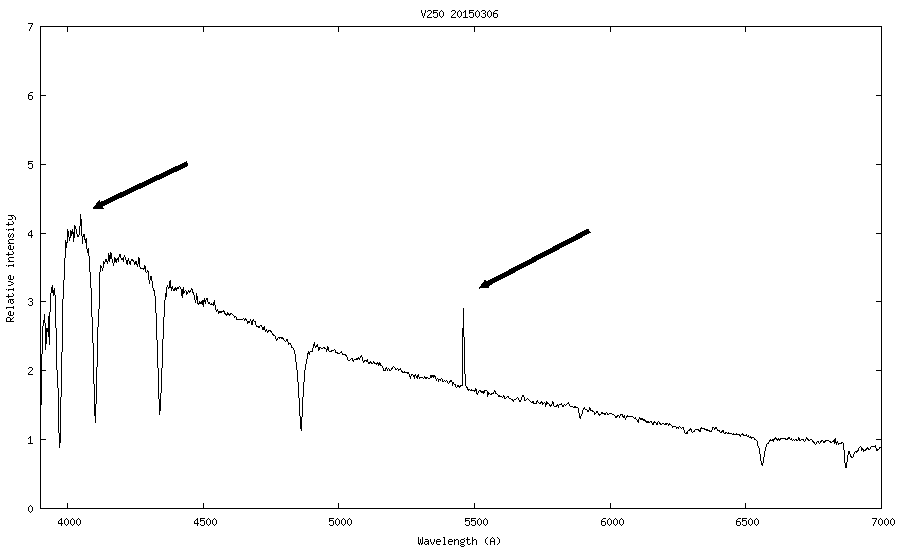Toujours un peu débutant, j’aimerais bien avoir votre avis sur un problème qui me semble lié à la pollution lumineuse du lieu d’où j’observe, mais je n’en suis pas sûr.
Il y a quelques jours, j’ai fait avec un LISA un spectre d’une étoile variable découverte par le survey de Dauban (http://www.aspylib.com/newsurvey/survey.html), il s’agit de V250.
L’objet est assez faible (mag 11), j’ai posé 11x300s, après prétraitement des images j’obtiens le spectre suivant.
http://www.astrosurf.com/astrild/V250 20150306.png
http://www.astrosurf.com/astrild/_v250_20150306_811.fit

Je ne pense pas que les deux pics en émission marqués par une flèche proviennent de la lumière de l’étoile, je pense plutôt à un artefact. J’ai repris plusieurs fois le traitement, contrôlé les prises unitaires à la recherche de cosmiques ou de points chauds, refait la courbe de rendement du spectro sans trouver la cause de ces deux pics.
Puis presque par hasard, en regardant un spectre de lampe au mercure fait avec un petit spectro jouet, je me suis rendu compte que ces deux pics se trouvaient à quelques angströms près à la même longueur d’onde que deux raies assez intenses des lampes au mercure utilisées par l’éclairage public soit 4070Å et 5460Å.
Je me dis donc que c’est peut-être la pollution lumineuse qui est la cause de ces deux pics en émission. Il est notable que sur le spectre de la même étoile fait l’année dernière sous un ciel plus noir, ces deux pics n’étaient pas visibles. Mais je dois aussi ajouter que j’ai fait d’autres spectres d’objets aussi faibles que V250 sous mon ciel pollué sans que l’on aperçoive ces deux pics, donc il y a peut-être une autre cause.
Dans le cas du spectre de V250, j’ai utilisé une fente double (étroite+photmétrique) et positionné l’étoile sur la fente étroite mais assez près de la limite entre fente fine et fente photométrique, du coup, pour ne pas empiéter sur la zone de la fente photométrique, j’ai dû réduire à 28 pixel la hauteur de la zone qui sert à l’évaluation du fond du ciel, c’est la première fois que j’utilise une hauteur aussi faible pour évaluer le fond de ciel, cela a peut être joué.
Autre hypothèse : j’ai raté quelque chose dans le traitement du spectre.
Merci d’avance
Abstract in broken English:
On a faint star (mag 11) spectrum I see two emissions lines that seem not to be due to the star itself. I assume that it could be light pollution (Hg lines 4070Å and 5460Å), but this the first time I notice this problem with my set-up. The set-up is a C11 EDGE reduced at F/D=0.7, LISA used with photometric slit, using the narrow part of the slit.
I am looking for an explanation and a way to remedy this problem.
Any advice will be welcome
Hubert